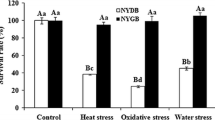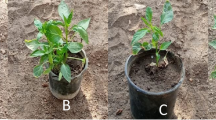Abstract
In this article, we investigated the effect of exogenous calcium on improving viability of Debaryomyces hansenii and Pichia membranaefaciens under heat stress, and evaluated the role of calcium in reducing oxidant damage of proteins in the yeast cells. The results indicated that high concentration of exogenous calcium in culture medium was beneficial for enhancing the tolerance of the biocontrol yeasts to heat stress. The possible mechanism of calcium improving the viability of yeasts was attributed to enhancement of antioxidant enzyme activities, decrease in ROS accumulation and reduction of oxidative damage of intracellular protein in yeast cells under heat stress. D. hansenii is more sensitive to calcium as compared to P. membranaefaciens. Our results suggest that application of exogenous calcium combined with biocontrol yeasts is a practical approach for the control of postharvest disease in fruit.



Similar content being viewed by others
References
Almagro A, Prista C, Castro S et al (2000) Effects of salts on Debaryomyces hansenii and Saccharomyces cerevisiae under stress conditions. Int J Food Microbiol 56:191–197
Bradford MM (1976) A rapid and sensitive method for the quantitation of microgram quantities of protein utilizing the principle of protein-dye binding. Anal Biochem 72:248–254
Cao SF, Zheng YH, Tang SS et al (2009) Improved control of anthracnose rot in loquat fruit by a combination treatment of Pichia membranaefaciens with CaCl2. Int J Food Microbiol 126:216–220
Castoria R, Caputo L, De Curtis F et al (2003) Resistance of postharvest biocontrol yeasts to oxidative stress: a possible new mechanism of action. Phytopathology 93:564–572
Davidson JF, Schiestl RH (2001) Mitochondrial respiratory electron carriers are involved in oxidative stress during heat stress in Saccharomyces cerevisiae. Mol Cell Biol 21:8483–8489
Droby S, Chalutz E, Wilson CL et al (1989) Characterization of the biocontrol activity of Debaryomyces hansenii in the control of Penicillium digitatum on grapefruit. Can J Microbiol 35:794–800
El-Tarabily KA, Sivasithamparam K (2006) Potential of yeasts as biocontrol agents of soil-borne fungal plant pathogens and as plant growth promoters. Mycoscience 47:25–35
Fan Q, Tian SP (2000) Postharvest biological control of Rhizopus rot of nectarine fruits by pichia membranefaciens. Plant Dis 84:1212–1216
Fedoseeva IV, Varakina NN, Rusaleva TM et al (2010) Effect of calcium ions on the Hsp104 synthesis and heat tolerance of Saccharomyces cerevisiae. Microbiology 79:153–159
Ippolito A, Nigro F (2000) Impact of preharvest application of biological control agents on postharvest diseases of fresh fruits and vegetables. Crop Prot 19:715–723
Janisiewicz WJ, Korsten L (2002) Biological control of postharvest diseases of fruits. Annu Rev Phytopathol 40:411–441
Janisiewicz WJ, Leverentz B, Conway WS et al (2003) Control of bitter rot and blue mold of apples by integrating heat and antagonist treatments on 1-MCP treated fruit stored under controlled atmosphere. Postharvest Biol Technol 29:129–143
Li BQ, Tian SP (2007) Effect of intracellular trehalose in Cryptococcus laurentii and exogenous lyoprotectants on its viability and biocontrol efficacy on Penicillium expansum in apple fruit. Lett Appl Microbiol 44:437–442
Liu J, Wisniewski M, Droby S et al (2011) Effect of heat shock treatment on stress tolerance and biocontrol efficacy of Metschnikowia fructicola. FEMS Microbiol Ecol 76:145–155
Madeo F, Herker E, Maldener C et al (2002) A caspase-related protease regulates apoptosis in yeast. Mol Cell 9:911–917
Moreno S, Klar A, Nurse P (1991) Molecular genetic-analysis of fission yeast Schizosaccharomyces Pombe. Methods Enzymol 194:795–823
Navarrete C, Siles A, Martínez JL et al (2009) Oxidative stress sensitivity in Debaryomyces hansenii. FEMS Yeast Res 9:582–590
Papouskova K, Sychrova H (2007) The co-action of osmotic and high temperature stresses results in a growth improvement of Debaryomyces hansenii cells. Int J Food Microbiol 118:1–7
Qin GZ, Tian SP, Chan ZL et al (2007) Crucial role of antioxidant proteins and hydrolytic enzymes in pathogenicity of Penicillium expansum: Analysis based on proteomic approach. Mol Cell Proteomics 6:425–438
Reverberi M, Fabbri AA, Zjalic S et al (2005) Antioxidant enzymes stimulation in Aspergillus parasiticus by Lentinula edodes inhibits aflatoxin production. Appl Microbiol Biotechnol 69:207–215
Reverter-Branchat G, Cabiscol E, Tamarit J et al (2004) Oxidative damage to specific proteins in replicative and chronological-aged Saccharomyces cerevisiae. J Biol Chem 279:31983–31989
Tian SP (2006) Microbial control of postharvest diseases of fruits and vegetables: current concepts and future outlook. In: Ray RC, Ward OP (eds) Microbial biotechnology in horticulture, vol 1. Science Publishers, Enfield, pp 163–202
Tian SP, Fan Q, Xu Y et al (2002) Effects of calcium on biocontrol activity of yeast antagonists against postharvest fungal pathogen. Plant Pathol 51:352–358
Yao HJ, Tian SP (2005) Effects of pre-and post-harvest application of salicylic acid or methyl jasmonate on inducing disease resistance of sweet cherry fruit in storage. Postharvest Biol Technol 35:253–266
Yoshimoto H, Saltsman K, Gasch AP et al (2002) Genome wide analysis of gene expression regulated by the calcineurin/Crz1p signaling pathway in Saccharomyces cerevisiae. J Biol Chem 277:31079–31088
Acknowledgments
Work in Tian Laboratory was supported by grants from the National Natural Science Foundation of China (31030051; 31172005) and the National High Technology Research (863) Program of China (2012AA101010).
Author information
Authors and Affiliations
Corresponding author
Rights and permissions
About this article
Cite this article
An, B., Li, B., Qin, G. et al. Exogenous Calcium Improves Viability of Biocontrol Yeasts Under Heat Stress by Reducing ROS Accumulation and Oxidative Damage of Cellular Protein. Curr Microbiol 65, 122–127 (2012). https://doi.org/10.1007/s00284-012-0133-4
Received:
Accepted:
Published:
Issue Date:
DOI: https://doi.org/10.1007/s00284-012-0133-4




